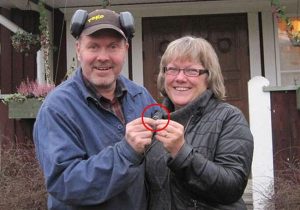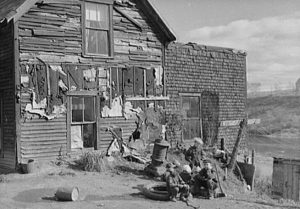potato peels
 In 1995, during the Christmas season, Lena Paahlsson was baking Christmas cookies with her daughters at their farm in northern Sweden. As was her habit while baking, Lena took off her wedding ring, and placed it on the counter. While they were cleaning up after baking, Lena could not find her ring. It was a devastating end to the year. Lena and her family hunted for the ring everywhere, even pulling up floorboards…hoping against hope, but to no avail. The ring had vanished…lost forever, or so they thought.
In 1995, during the Christmas season, Lena Paahlsson was baking Christmas cookies with her daughters at their farm in northern Sweden. As was her habit while baking, Lena took off her wedding ring, and placed it on the counter. While they were cleaning up after baking, Lena could not find her ring. It was a devastating end to the year. Lena and her family hunted for the ring everywhere, even pulling up floorboards…hoping against hope, but to no avail. The ring had vanished…lost forever, or so they thought.
Then, one day in October 2011, while she was pulling the last of the carrots from her garden, Lena was stunned to see her wedding ring wrapped neatly around the top of the carrot. Lena had given up hope of ever finding the ring she cherished. The family speculates that the ring must have fallen into the sink, and been mixed with the potato peels that were later composted or fed to the sheep, because the soil in the garden is made from composted vegetables and sheep dung. They have no idea why it took 16 years for the ring to work its way to the surface again, but they are sure that if the ring had not had a tiny carrot seed land in its middle, it would have still be  hiding there in the rich dirt of the garden. In the end, it was a Carat Carrot that returned her ring to her.
hiding there in the rich dirt of the garden. In the end, it was a Carat Carrot that returned her ring to her.
Unfortunately, after all these years, the ring no longer fits Lena. It will need to be sized before she can wear it again. They fact certainly didn’t dim the joy and happiness the family felt at the return of the precious ring. Lena says, “I had given up hope. Now that I have found the ring again I want to be able to use it.” I’m sure that the Carat Carrot made the meal it was used in just that much better. Imagine…the carrot had a very special job to do, before it went on to do what it was destined to do in the first place.
 When the Great Depression hit, people in the upper-middle class, like doctors, lawyers, and other professionals, saw their incomes drop by 40%, but the middle class and low income Americans found themselves with nothing. They had no jobs and no money, and even if they did have those things, they couldn’t afford the things they needed. The prices for everything from food to clothing were much more than their meager income could buy much of. People began to move from place to place looking for a job…any job. The problem was that there were very few jobs, and lot of people standing in line to get them. The average American lived by the Depression-era motto: Use it up, wear it out, make do, or do without. People had to learn to be frugal. Clothes were patched when the started to wear out. People planted gardens and even kept little gardens in their kitchen. They stayed home, instead of evenings out. They were always in a private struggle to keep their cars or homes.
When the Great Depression hit, people in the upper-middle class, like doctors, lawyers, and other professionals, saw their incomes drop by 40%, but the middle class and low income Americans found themselves with nothing. They had no jobs and no money, and even if they did have those things, they couldn’t afford the things they needed. The prices for everything from food to clothing were much more than their meager income could buy much of. People began to move from place to place looking for a job…any job. The problem was that there were very few jobs, and lot of people standing in line to get them. The average American lived by the Depression-era motto: Use it up, wear it out, make do, or do without. People had to learn to be frugal. Clothes were patched when the started to wear out. People planted gardens and even kept little gardens in their kitchen. They stayed home, instead of evenings out. They were always in a private struggle to keep their cars or homes.
Paint was too expensive, so home fell into disrepair. As things got worse, things began to wear out, and people didn’t get rid of the junk. They simply put it out in the yard. I’m sure that they realized that every piece of junk had parts in it that could be used for repairs to something else. Everything could be reworked. They used the  backs of worn-out overall legs to make pants for little boys and overalls for babies. They didn’t have disposable diapers back then. They made diapers and underwear out of flour and sugar sacks. When the older kids outgrew their clothes, but they were too big for the younger kids, they made smaller clothes out of bigger hand-me-downs. If their shoes wore out before a year, the children went barefooted. Many people resorted to bartering…not only goods for goods, but work for work. They tried to make their homes and their lives pretty, even in depressing times. They used patterned chicken feed sacks to make curtains, aprons, and little girl’s dresses. Worn out socks were kept, so that they could patch another sock. Nothing was thrown away. They saved string that came loose from clothing and added it to a string ball for mending and sewing. Toilet paper was a luxury that many people couldn’t afford, so they used newspaper instead. They saved every scrap of material for making quilts. People learned not to waste anything.
backs of worn-out overall legs to make pants for little boys and overalls for babies. They didn’t have disposable diapers back then. They made diapers and underwear out of flour and sugar sacks. When the older kids outgrew their clothes, but they were too big for the younger kids, they made smaller clothes out of bigger hand-me-downs. If their shoes wore out before a year, the children went barefooted. Many people resorted to bartering…not only goods for goods, but work for work. They tried to make their homes and their lives pretty, even in depressing times. They used patterned chicken feed sacks to make curtains, aprons, and little girl’s dresses. Worn out socks were kept, so that they could patch another sock. Nothing was thrown away. They saved string that came loose from clothing and added it to a string ball for mending and sewing. Toilet paper was a luxury that many people couldn’t afford, so they used newspaper instead. They saved every scrap of material for making quilts. People learned not to waste anything.
Every part of the food was used. Potato peels were food, not waste. They made soup out of a few vegetables and a scrap of meat…for flavor only. They hunted for rabbits and fished to put what protein they could on the table. When there was nothing more to eat, they had lard sandwiches. I seriously doubt if many people went to  bed with a full stomach, but that didn’t mean that you turned away a stranger who was hungry. These people knew hw bad things were for them, and so they helped their neighbors. Nevertheless, during the Great Depression, suicide rates in the United States reached an all-time high, topping 22 suicides per 100,000 people. The living conditions were deplorable, and many people couldn’t take it. They felt that somehow they were at fault. still, for the majority of Americans, that didn’t mean that they gave up. Neighbor looked out for neighbor, and families came together to support each other, and while the effects of the Great Depression lasted for 12 years, this too passed, and the nation healed again.
bed with a full stomach, but that didn’t mean that you turned away a stranger who was hungry. These people knew hw bad things were for them, and so they helped their neighbors. Nevertheless, during the Great Depression, suicide rates in the United States reached an all-time high, topping 22 suicides per 100,000 people. The living conditions were deplorable, and many people couldn’t take it. They felt that somehow they were at fault. still, for the majority of Americans, that didn’t mean that they gave up. Neighbor looked out for neighbor, and families came together to support each other, and while the effects of the Great Depression lasted for 12 years, this too passed, and the nation healed again.

